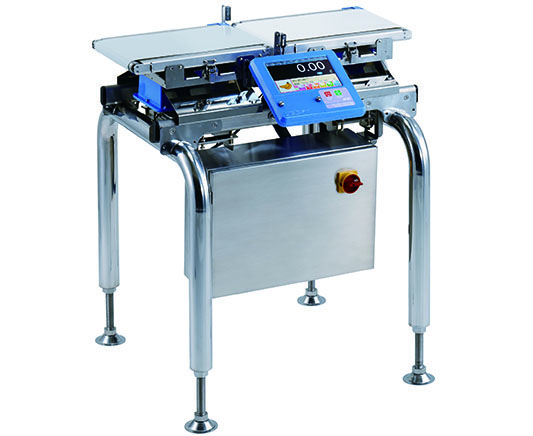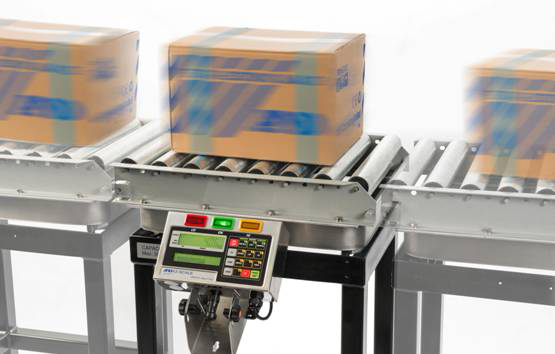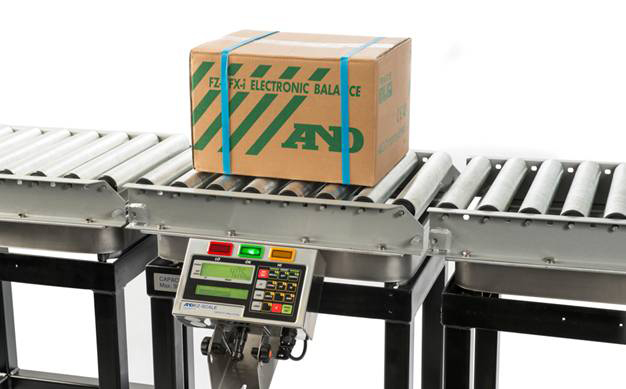
Are you required to ensure you supply correct weights to supermarkets and other clients? The EZI-Check™ inspection system is our new high speed inline checkweigher that’s been specially designed to weigh, classify and segregate products based on weight.

For product packs that are less than 600g, this high accuracy checkweigher can help to minimize the giveaway of materials above the specified weight and contribute to reductions in production costs. Capacity 600g x 0.01g

The new EZI-Check freestanding powered roller weighing systems can be incorporated into new or existing process control systems, allowing precise checking of cartons for missing or damaged products.

A&D’s new EZI-Check freestanding roller weighing systems can be incorporated into new or existing production lines allowing precise checking of cartons for missing or damaged products.
Benefits of Checkweighers
Many businesses around the world use checkweighers because of the significant benefits that they provide, including:
Improved Accuracy and Reduced Waste
One of the major benefits of using a checkweigher is that they can improve on your production processes’ accuracy and limit the amount of waste and giveaway. Less product giveaway translates to savings and reduction in costs.
Better Product Quality
One of the most important steps in the quality control process is ensuring that your packages are consistent. Using a checkweigher will improve the accuracy of the weight of your products, ensure consistency, and speed up the entire checking process.
Ensure Compliance
If you are selling your product on a retail level and it displays the weight on the package, then a checkweigher is absolutely essential to ensure that the actual product weight is 100% accurate. This ensures compliance with industry and regulatory standards, and helps you avoid costly fines.
Data Collection
Checkweighers can seamlessly collect data from every product that passes the conveyor belt and stores the information in a USB drive. Collecting accurate data allows the management team the ability to keep track of unique aspects of the production process. They can then use this to identify which aspects of the production process are not up to par with their goals.
Increase & Track Productivity
Most checkweighing systems provide detailed information about the output of the production process. Subsequently, the management team can keep track of how productive the process is, track the performance of employees, and make improvements to increase productivity.
Features & Specifications of A&D Checkweighers
Most checkweighing systems provide detailed information about the output of the production process. Subsequently, the management team can keep track of how productive the process is, track the performance of employees, and make improvements to increase productivity.
Features
- Best-in-class precision with top speed digital signal processing
- Easy to use LCD colour touch panel
- Meets the requirement of hygienic food processing
- Unique modular design ensures simple installation, easy relocation, and takes up minimal space
- Full interaction via Modbus ethernet comms
- Data capture ensures QA reporting, and it records operational history
- Quick and efficient transfer of data/information via USB
- Optimal weighing conditions can be automatically set
- Users can register and their scope of permitted operations controlled according to 4 management level
- Rejector output, alarm output, metal detector input, RS-232C, TCP/IP and USB interface are equipped as standard
- Histogram, X/R control charts and can output summary reports to a PostScript printer via Ethernet
- Protected from dust and water to IP65 standards
Specifications
- 7 inch colour touch screen panel with user friendly interface
- Save up to 1000 product IDs with images
- Systems is protected from dust and water to IP65 standards
- Equipped with modbus communication RTU / Modbus TCP as standard
- Various Capacities available: 600g, 2kg, 6kg and larger custom capacities
FAQs
What are the components of a checkweigher?
There are several components that work together to make up a checkweigher. Here are the typical components that you would find in a checkweigher:
- Infeed section
- Weighing section that has a weighing/loading cell
- Outfeed section that uses a sorting/rejection device
- Weighing terminal
- Solid and vibration minimising frame
Keep in mind that there are distinct types of checkweighers, and manufacturers make them differently. The unique components and details of the checkweigher will vary depending on the use of the end consumer.
What are the differences between a static and dynamic checkweigher?
Two of the major checkweighers that you should become acquainted with our static and dynamic. The difference between these two are made apparent in the names. A static checkweigher weighs items that are still whereas a dynamic checkweigher weighs items in motion.
Static check wires are a more labor-intensive machine to operate. With a static checkweigher, the user has to weigh each product manually. Therefore, people typically use them for spot checking.
With a dynamic checkweigher, the entire process is 100% automated. It weighs products as they move through the production line and will sort out any products that do not weigh the correct amount.
Why do you need an inline checkweigher in your production?
Checkweighers are a key piece of the production process. They make quality control much easier for companies, and will therefore improve quality and efficiency. Here are some primary reasons for an inline checkweigher in your production:
- Avoid fines by meeting regulatory standards
- Save material by cutting down on waste
- Improve the overall production process and increase efficiency
- Reduce product giveaway and save money

